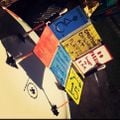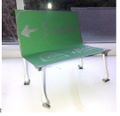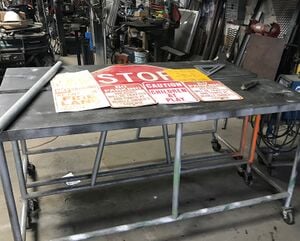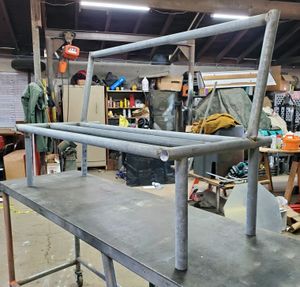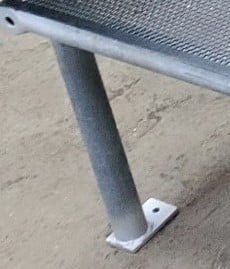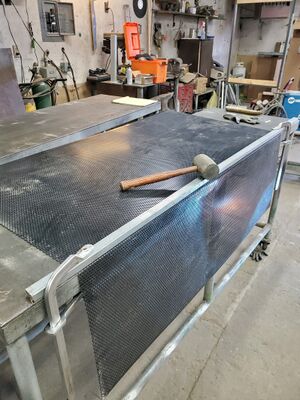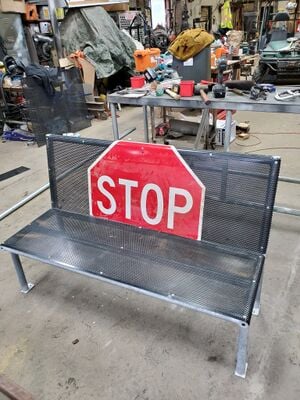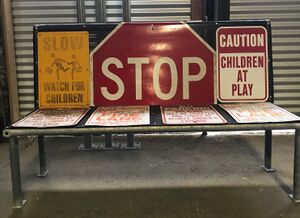
Abstract[edit | edit source]
The purpose of this project is to provide aesthetically-pleasing outdoor seating for the students of Catherine L. Zane Middle School in Eureka, California, and to incorporate upcycled materials into the final product. Throughout the duration of the project, a specific engineering design process was followed. Initial stages of the project included information gathering and problem analysis. Many different bench styles were explored in the planning process and multiple prototypes developed. The final design fulfills the criteria most appropriately and consists of welded galvanized steel and street signs obtained from various sources.
Background[edit | edit source]
This project was developed by Team HANI, a collection of Cal Poly Humboldt students in the Engineering 215 course instructed by Lonny Grafman during the Spring of 2019. Team HANI includes the members: India Eichelbaugh-Goss, Nicholas Kenne, Andie Kolasinski, and Hayden Miller. The client for the upcycled bench project is Catherine L. Zane Middle School, and the specific representative working closely with Team HANI is Trevor Hammons. Zane Middle School is a "STEAM" school; this descriptive acronym stands for "Science, Technology, Engineering, Arts, and Mathematics". This project will play a role in educating middle school students about waste-reduction in an effort to promote sustainable practices by utilizing materials that would have otherwise been discarded.
Problem statement and criteria[edit | edit source]
Zane Middle School in Eureka, California lacks aesthetically pleasing outdoor seating arrangements for its students near the after-school pickup area. Team HANI's mission is to provide an upcycled bench that will allow students to comfortably wait for their parents after school, while reducing waste in the community and making the campus more colorful and vibrant.
| Criteria | Importance | Constraints |
|---|---|---|
| Safety | 9 | Meets or exceeds school district standards |
| Aesthetically Pleasing | 8 | > Onsite Benches |
| Upcycled-ness | 7 | > 50% |
| Durability | 7 | Equal to onsite benches |
| Cost | 6 | < $400 |
| Comfort | 6 | > Onsite benches |
Description of Final Project[edit | edit source]
-
Upcycled Bench
The upcycled bench for Zane Middle School is a bench made with materials that would otherwise be garbage in order to promote the sustainable practice of upcycling. These materials include galvanized steel, perforated metal, multi-colored street signs, rivets, and flanges. The bench allows up to three students to sit on it at once and is meant to provide an extra hang-out spot for the students while helping the faculty keep an eye on the students while they wait to be picked up after school. This upcycled bench has the option of being stationary due to its design with flanges on the bottom of the bench legs.
Prototyping[edit | edit source]
Through the prototype phase, Team HANI learned that street signs were aesthetically-pleasing to the eye. Also, adding a perforated metal sheet where people place their weight will add extra strength to the bench. By adding a flange with a hole to drill a lag bolt through to each leg of the bench, it will allow the bench to be held stationary.
-
One of the original prototypes for aesthetics.
-
2nd prototype for aesthetics.
-
Welded flange prototype.
-
Welded flange model.
-
Final prototype for design and structure.
Costs[edit | edit source]
Team HANI had a budget of $400, but no purchases were made due to the support of many generous donors. Listed below are the donors and details about the specific contributions.
| Donors | Donation Date | Description |
|---|---|---|
| Town and Country Mobile Villa (maintenance crew) | 02/25/20 | Five street signs - previously used around Town and Country Mobile Villa in Arcata, California |
| Andie Kolasinski | 02/28/20 | One street sign – found abandoned in Arcata Community Forest |
| Miller Farms | 04/05/20 | One large stop sign – found in barn at Miller Farms |
| Miller Farms | 04/09/20 - 04/23/20 | Labor – welding and general construction of frame and galvanized pipe |
Testing Results[edit | edit source]
Students love the sleek design of the bench. Student appeal was tested with the help of a teacher named Mr. Stevenson who works at St. Bernard's Academy in Eureka, California. A survey was conducted among his 18 students by presenting them with a photograph of the completed upcycled street sign bench and asking if thy would enjoy having such a bench installed on their campus. These 18 students unanimously said "Yes" and confirmed that the street sign bench is appealing to middle school-aged students. A functionality aspect of the bench was tested with different types of weld designs that were used on various construction jobs that were completed by Miller Farms, a landscape and construction workplace located in McKinleyville, California. After the completion of the bench the weight capacity was tested, and proved to support up to 800 pounds; the bench was able to hold four adults without compromising the integrity of the welds on the bench frame.
How to build[edit | edit source]
Gather the materials needed: Galvanized steel pipes (4 of one uniform length for legs, 4 of one uniform length for lengthwise back and seating supports, 2 of one uniform length for the height of the backrest, and 2 of yet another uniform length for the width of the seating portion), street signs (we used 7, but this can be adjusted based on the desired size and aesthetic design of the bench), one sheet of perforated metal (we used a 40" by 58" sheet), 4 flanges, and 54 rivets.
Using a pop rivet gun, attach rivets to hold the perforated metal sheet to the frame. Then, using the same method, attach street signs to the perforated metal sheet. By using rivets rather than screws that could protrude from the bench and pose a safety hazard due to their sharpness, the chance of injury resulting from using the bench is eliminated.
Maintenance[edit | edit source]
The upcycled bench will need very minimal maintenance, as it is weatherproof and very sturdy.
Schedule[edit | edit source]
- Every year
- Check the tightness of the rivets to ensure they are still holding the signs securely; replace rivets if loose.
- Wipe down the bench if it has gotten dirty.
- When Desired
- The signs on the bench may be interchanged in order to update the aesthetic aspect of the bench. This will require removing the rivets that attach the sign(s), removing the sign(s), and attaching new sign(s) using new rivets.
Instructions[edit | edit source]
Maintenance of the bench is minimal. For aesthetic purposes, make sure to keep the bench clean clean by rubbing the bench down with a cloth rag or spraying it down with water. Check the rivets every year by wiggling them back and forth. If a rivet is loose, replace it with a new one. This can be done by using a rivet removal tool for removal of old rivets, and a pop rivet gun for installation of new rivets.
Troubleshooting[edit | edit source]
These are simple troubleshooting steps for basic operation. For complex issues, please contact Hayden Miller via email at Hem39@humboldt.edu
| Problem | Suggestion |
|---|---|
| Signs look old and faded. | Simply undo rivets, remove signs, and install new rivets to attach new signs! |
| Bench is dirty. | Use a moist rag to wipe down. |
| Bench materials become loose | Using a rivet removal tool, undo the rivets. Using a pop rivet gun, replace them with new ones. |
Suggestions for future changes[edit | edit source]
In the future, a bench could be made longer (or multiple benches could be made) in order to accommodate more students at one time. Another change that could be made is implementing diamond-grade signs rather than engineering-grade signs; the difference is the level of reflectivity, and diamond-grade signs would provide a brighter and more vibrant final design.

